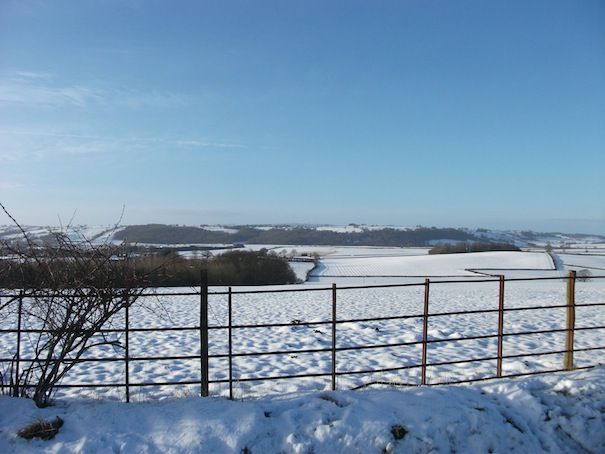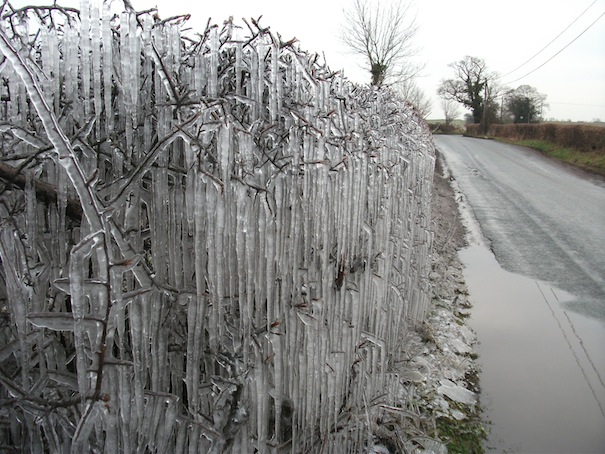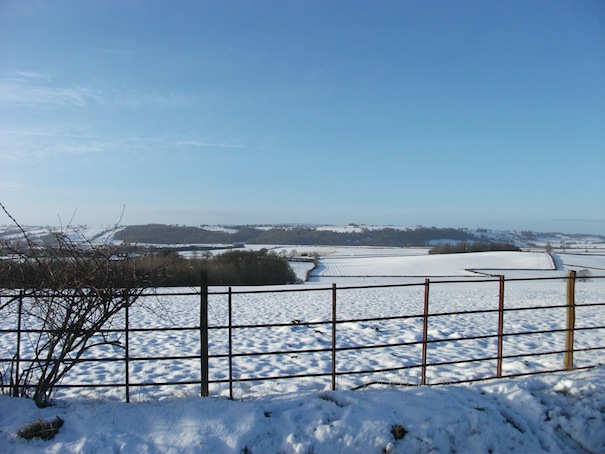
A peculiar silence envelops the countryside when we have periods of heavy snowfall. The snow seems to dull the normal echoes that one hears when out walking. The stillness is almost hypnotic.
My favourite time to go for a walk through the snow is just as the moon is rising. The moonlight reflects off the snow and the landscape seems to glow. Amongst the trees, paths that are normally uneven with roots and hollows are levelled by the thick snow. The path surface soon resembles a freshly iced cake.
Snow makes the invisible visible. In the corner of the woodland, the wind has blown the snow into a deep drift. Normally the direction of the wind is hard to visualise. The ripples in the snow drift make this easy. Other secrets are also revealed in the snow. Our native wild animals generally lead hidden lives but they leave characteristic signs in these wintry conditions that indicate their movements.
After a bout of snowfall, I take a walk through the countryside between Bridgnorth and Broseley. Walking through a large field, I spot a hare suddenly break cover. I am always amazed by the turn of speed that these animals are capable of. I watch the hare fly across the snowy surface, ears pinned back in perfect, streamlined symmetry. He runs with a lolloping stride and I soon manage to find his footprints in the snow. Both hare and rabbit tracks are quite similar. The hind legs of both animals leave elongated slipper-shaped prints. The forelegs leave a more circular impression and are often very close together. The size difference between rabbits and hares can clearly be seen from the tracks.
Through an old gate and into another field, I spot some fox prints. The fox has walked up and down the field edge many times. Where the animal has had to cross the open field, there are only two sets of tracks. The wily fox clearly prefers the cover that the hedgerow affords. I can even see where the fox has scent- marked, a yellow patch in the snow is a sure giveaway! The tracks eventually drop down into a tangle of trees beyond the hedgerow. I wonder if the fox made a kill last night. Severe winter weather can be a harsh time for predators.
 Alongside the frosty hedge, I find the tracks of a pheasant. They have three long toes on each foot and it’s possible to see an impression of a claw at the end of each toe. I can even see two lines in the snow where the long tail has dragged along the surface.
Alongside the frosty hedge, I find the tracks of a pheasant. They have three long toes on each foot and it’s possible to see an impression of a claw at the end of each toe. I can even see two lines in the snow where the long tail has dragged along the surface.
Eventually I reach the old railway line and start walking back towards Bridgnorth. I look across the river and can see the trees dusted with snow. I spot a different type of footprint along the track. I recognise it as a cloven hoof (a type of hoof that is split into 2 toes). The main suspect in this case is either a fallow deer or a sheep. I take a photo and later study my books. It seems that it is a sheep print as deer generally have more pointy toes.
It has been said that March enters like a lion and leaves like a lamb. The situation is generally more complex than that. Cold snaps are interspersed with milder conditions. This can make it very tricky for animals that are in hibernation to regulate their activity. The snow that we have had this winter has been characterised by a very rapid thaw. Icicles hanging from the hedges quickly melted and snow turned to slush. The melt water flooded fields and streams became swollen.
I am walking through the Wyre Forest near Bewdley. There is a strong breeze that shakes the trees. The veterans of the forest are shedding their deadwood that has been loosened by the frost. Twigs and pine cones are raining down all around me. I can feel the warmth of the sunshine on my face. I am in a part of the forest that still supports a population of adders. The snakes will be hibernating underground and beneath log piles. As the ground warms up, the snakes will emerge. The male snakes will be first to appear, often in March. They can sometimes be seen doing a delicate ‘dance’ in the Spring sunshine, in order to establish territories. The snow drifts and ice are but a distant memory.
Do one thing for wildlife this month:
Why not practise your own tracking skills? The best time to find footprints in the countryside is after snowfall. Another option is to set up a ‘track trap’. To do this, simply find a suitable place in the garden and dig a shallow hole. Set a plastic tray in the hole so that the top of the tray is at ground level. Fill the hole with some sharp sand and moisten it. Smooth over the sand and wait and see what footprints you get. You might be surprised to discover what animals are busy in your garden after dark!






